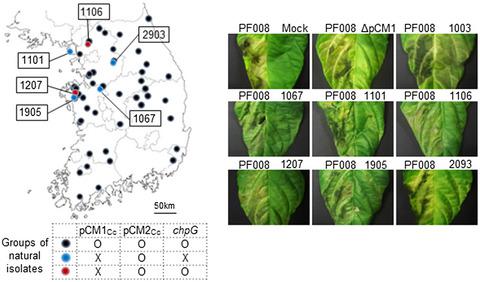当前位置:
X-MOL 学术
›
Mol. Plant Pathol.
›
论文详情
Our official English website, www.x-mol.net, welcomes your
feedback! (Note: you will need to create a separate account there.)
Plasmid composition and the chpG gene determine the virulence level of Clavibacter capsici natural isolates in pepper.
Molecular Plant Pathology ( IF 4.8 ) Pub Date : 2020-03-20 , DOI: 10.1111/mpp.12932 In Sun Hwang 1 , Hyo Min Lee 1 , Eom-Ji Oh 1 , Seungdon Lee 2 , Sunggi Heu 3 , Chang-Sik Oh 1
Molecular Plant Pathology ( IF 4.8 ) Pub Date : 2020-03-20 , DOI: 10.1111/mpp.12932 In Sun Hwang 1 , Hyo Min Lee 1 , Eom-Ji Oh 1 , Seungdon Lee 2 , Sunggi Heu 3 , Chang-Sik Oh 1
Affiliation

|
The gram‐positive bacterial species Clavibacter capsici causes necrosis and canker in pepper plants. Genomic and functional analyses of C. capsici type strain PF008 have shown that multiple virulence genes exist in its two plasmids. We aimed to identify the key determinants that control the virulence of C. capsici. Pepper leaves inoculated with 54 natural isolates exhibited significant variation in the necrosis. Six isolates showed very low virulence, but their population titres in plants were not significantly different from those of the highly virulent isolates. All six isolates lacked the pCM1Cc plasmid that carries chpG, which has been shown to be required for virulence and encodes a putative serine protease, but two of them, isolates 1,106 and 1,207, had the intact chpG elsewhere in the genome. Genomic analysis of these two isolates revealed that chpG was located in the pCM2Cc plasmid, and two highly homologous regions were present next to the chpG locus. The chpG expression in isolate 1,106 was not induced in plants. Introduction of chpG of the PF008 strain into the six low‐virulence isolates restored their virulence to that of PF008. Our findings indicate that there are at least three different variant groups of C. capsici and that the plasmid composition and the chpG gene are critical for determining the virulence level. Moreover, our findings also indicate that the virulence level of C. capsici does not directly correlate with bacterial titres in plants.
中文翻译:

质粒组成和 chpG 基因决定辣椒中辣椒棒杆菌天然分离株的毒力水平。
革兰氏阳性细菌辣椒棒杆菌会导致辣椒植物坏死和溃疡。对辣椒辣椒型菌株PF008的基因组和功能分析表明,其两个质粒中存在多个毒力基因。我们的目的是确定控制辣椒念珠菌毒力的关键决定因素。接种 54 个天然分离株的辣椒叶在坏死方面表现出显着的变化。六个分离株表现出非常低的毒力,但它们在植物中的群体滴度与高毒力分离株没有显着差异。所有六个分离株均缺乏携带chpG 的pCM1 Cc质粒,该质粒已被证明是毒力所必需的并编码推定的丝氨酸蛋白酶,但其中两个分离株(分离株 1,106 和 1,207)在基因组的其他位置具有完整的chpG。对这两个分离株的基因组分析表明,chpG位于 PCM2 Cc质粒中,并且chpG基因座旁边存在两个高度同源的区域。分离株 1,106 中的 chpG表达未在植物中诱导。将PF008 菌株的chpG引入 6 个低毒力分离株中,使其毒力恢复到 PF008 的水平。我们的研究结果表明,辣椒念珠菌至少存在三种不同的变体组,并且质粒组成和chpG基因对于确定毒力水平至关重要。此外,我们的研究结果还表明,辣椒念珠菌的毒力水平与植物中的细菌滴度并不直接相关。
更新日期:2020-03-20
中文翻译:

质粒组成和 chpG 基因决定辣椒中辣椒棒杆菌天然分离株的毒力水平。
革兰氏阳性细菌辣椒棒杆菌会导致辣椒植物坏死和溃疡。对辣椒辣椒型菌株PF008的基因组和功能分析表明,其两个质粒中存在多个毒力基因。我们的目的是确定控制辣椒念珠菌毒力的关键决定因素。接种 54 个天然分离株的辣椒叶在坏死方面表现出显着的变化。六个分离株表现出非常低的毒力,但它们在植物中的群体滴度与高毒力分离株没有显着差异。所有六个分离株均缺乏携带chpG 的pCM1 Cc质粒,该质粒已被证明是毒力所必需的并编码推定的丝氨酸蛋白酶,但其中两个分离株(分离株 1,106 和 1,207)在基因组的其他位置具有完整的chpG。对这两个分离株的基因组分析表明,chpG位于 PCM2 Cc质粒中,并且chpG基因座旁边存在两个高度同源的区域。分离株 1,106 中的 chpG表达未在植物中诱导。将PF008 菌株的chpG引入 6 个低毒力分离株中,使其毒力恢复到 PF008 的水平。我们的研究结果表明,辣椒念珠菌至少存在三种不同的变体组,并且质粒组成和chpG基因对于确定毒力水平至关重要。此外,我们的研究结果还表明,辣椒念珠菌的毒力水平与植物中的细菌滴度并不直接相关。










































 京公网安备 11010802027423号
京公网安备 11010802027423号